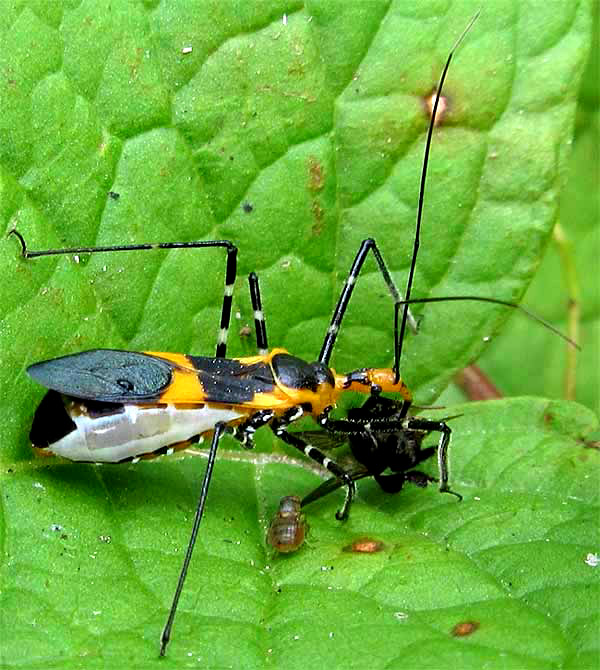Excerpts from Jim Conrad's
Naturalist Newsletter
from the March 6, 2016 Newsletter issued from Hacienda Chichen Resort beside Chichén Itzá Ruins; limestone bedrock; elevation ~39m (~128ft), N20.675°, W88.569°; central Yucatán state, MÉXICO
LONGLEGGED ASASSIN BUG

While volunteer insect identifier Bea of Ontario was here she photographed many insects other than butterflies, including the bug shown above, with its straw-like proboscis inserted into the body of its prey, and its abdomen bloated with sucked-up juices.
Bea identified that as ZELUS LONGIPES, which often goes by the name of Milkweed Assassin Bug because its colors are similar to those of the well known Milkweed Bug. However, other than that, the bug has nothing to do with milkweeds, so I prefer another of its common names, the Longlegged Assassin Bug. The binomial, Zelus longipes, is an old one, bestowed by Linnaeus himself.
Long-legged Assassin Bugs are widely distributed and common from the southern tier of US states south through Mexico and the Caribbean and Central America to Argentina and Chile in South America. With such a big distribution, it displays many color variations. One secret to its success is that it feeds on a wide range of soft-bodied prey, from flies, mosquitoes and beetles to caterpillars and even earthworms.
Long-legged Assassin Bugs catch their prey using the "sticky trap strategy," which consists of hiding in leafy places with its forelegs raised ready to pounce. In Bea's picture you can see that the forelegs are covered with pale hairs, which apparently are sticky, so prey grabbed with the legs are less likely to escape. The assassin bug quickly stabs its proboscis's needle-like stylets into the prey's body and injects the prey with enzymes that cause tissue to liquefy so that it can be sucked up through the proboscis.
Though anyone clumsily handling a Long-legged Assassin Bug might suffer a "bite" that swells and burns awhile, the species is thought of favorably as an important predator of species that often damage crops, such as Fall Armyworms and Asian Citrus Psyllids.